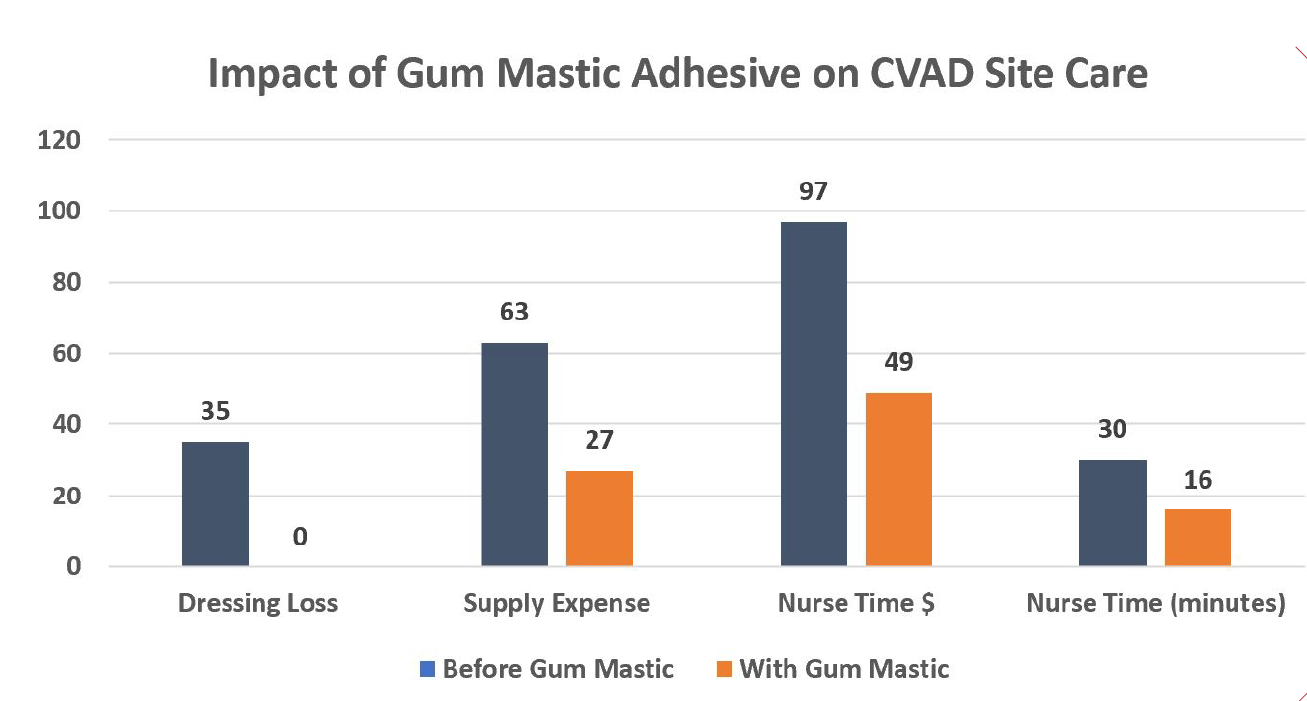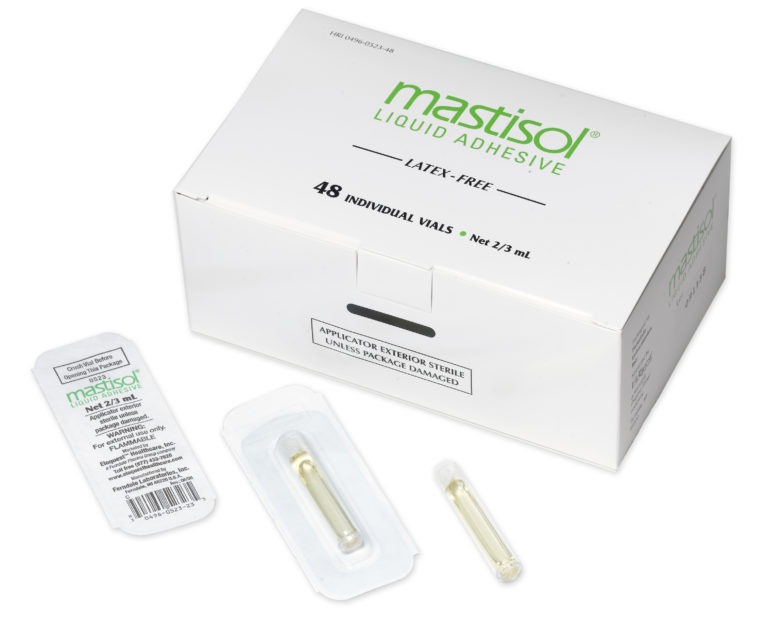
S. Matthew Gibson’s webinar “Pitfalls of Catheter Securement: The Dressing (Part 2)” explores different modalities and efficacies of catheter securement, identifies common causes of securement failure, and emphasizes the difference between stabilization and securement. Gibson also reviews the INS best practice recommendations for vascular access device and dressing securement, delving into the benefits of gum mastic adhesive as dressing enhancement.
Stabilization vs Securement
The terms “stabilization” and “securement” are not interchangeable. A device/dressing can be secured, but not stabilized. For instance, a catheter could be secured to a patient’s skin, but move significantly within the vein during movement or respiration.
Even though a catheter may appear stabile from an external perspective, ultrasounds often reveal issues with the indwelling portion of the catheter. With central lines, even a patient’s breathing can cause significant catheter movement within the vein.
Both securement and stabilization are key to preventing catheter/device dislodgement.
Modalities of Catheter Securement
There are many ways to achieve catheter securement and stabilization. These modalities can be generally categorized into mechanical and adhesive securement.
To explore these options further, Gibson conducts a demonstration of vascular access device securement options, testing the amount of pull‐force (in lbs) that cause different modalities to fail. Failure is defined as the catheter pulling out or away from the substrate. A key takeaway is that intact dressing enhances securement, resulting in approximately 2.5 times greater pull force needed for the catheter to “fail” than if no dressing was present. Another finding is that transparent semipermeable membrate (TSM) dressing (bordered) securement with gum mastic outperforms a normal TSM (bordered) securement, with the gum mastic version taking 12.82 lbs to fail instead of 10.83 lbs.
For more details, including the top tier combinations, view the webinar here.
Complications and Prevalence of Peripheral Intravenous Catheters (PIVCs)
PIVC insertion is one of the most common clinical procedures in hospitals, with 350M IV catheters sold annually in the US to support the demand.¹’² With the majority of hospitalized patients requiring a PIVC, it is important to make sure these devices are safe and efficient.¹ However, approximately 63% of PIVCs fail before therapy is completed, due to dislodegment, phlebitis, occlusion, infiltration, or infection.³ Of these complications, catheter dislodgement accounts for 7% of PIVC failure.³ Gibson emphasizes that these statistics are based only on reported issues, while many complications are not visible during external observation.
The Importance of Dressing Adherence
Dressing adherence is key in catheter site care and maintenance. The main benefits of proper dressing adherence include:
- Protection and stabilization: prevents catheter migration, device dislodgement, and infiltration.
- Reduced unnecessary dressing changes: decreases risk of infection, reduces risk of catheter‐associated skin injury, lowers labor and material costs, and improves patient
Gibson refutes the claim that dressings usually remain in place for 7 days, pointing out the average dressing is changed every 50 hours.*⁴ This is a serious issue, as each consecutive dressing disruption is linked to higher rates of infection.⁵
*Note—50 hours calculated by averaging medians reported by Richardson, et al. 2015.
Common reasons for dressing failure include:
- Dressing disruption: due to blood, moisture, hair growth,
- Wear and tear: due to bathing, excessive force, daily activities/movement, or natural skin replacement.
- Relationship between insertion and care/maintenance: due to poor insertion site and positioning.
Proper insertion site and positioning has an impact on dressing care and maintenance. Ensuring a catheter of appropriate length is inserted in the right spot (healthy, flat surface away from joint movement) can prevent issues from arising later.
Benefits of Gum Mastic as Dressing Adhesive
Gum mastic is a liquid medical adhesive. It is used to secure dressings, tapes, and devices over extended periods of time. According to the Infusion Therapy Standards of Practice (SOP) 38, the use and benefits of gum mastic liquid adhesive should be considered when increased adherence is needed.⁶
Gum mastic adhesive offers many benefits for patients and providers. It has been found to improve dressing integrity from current standards of care.⁷ In one study, 96% of 30,049 dressings applied with gum mastic adhesive were declared fully intact upon direction observation.⁸ Use of gum mastic as a dressing enhancement can also greatly reduce risk of infection with no reported increase in adhesive‐related skin injury.⁸’⁹ In
another study, the introduction of gum mastic adhesive reduced CLABSI rates by 76% over one year.⁹
Gum mastic not only increases healthcare efficacy, it also has significant economic impacts. As seen in the graph below, gum mastic adhesive use greatly reduces dressing loss, supply expense, nurse time ($), and nurse time (minutes).⁷

Graph replicated from webinar with data pulled from: Elena Nelson Squires BSN, RN, OCN, VA‐BC et al. Presented at the Association for Vascular Access National Conference 2019.
Eloquest Healthcare, Inc. offers Mastisol Liquid Adhesive, a gum mastic adhesive used to secure dressings, tapes, and certain medical devices. For more information about Mastisol Liquid Adhesive, please contact your sales consultant or Eloquest Healthcare, Inc. by calling 1‐877‐433‐7626 or completing this form.
Access the full Pitfalls of Catheter Securement: The Dressing (Part 2) webinar here.
References
- Alexandrou E, Gillian Ray‐Barruel, BSN, BA, ICU, Cert, Peter J Carr, Dip HE Nurs, H Dip A&E Nursing, BSc, MMedSc (Health Informatics), Steven A Frost, Sheila Inwood, CNS, Niall Higgins, GDipeH, Frances Lin, Laura Alberto, BN, MEd Com.Sc, Mermel L, Claire M Rickard, RN GradDip N(CritCare), PhD, FAHMS FACN, OMG Study Group, Use of Short Peripheral Intravenous Catheters: Characteristics, Management, and Outcomes Worldwide. J Hosp Med. Online Only. May 30, 2018. doi: 10.12788/jhm.3039.
- Lee Steere, Cheryl Ficara, Michael Davis, Nancy Moureau; Reaching One Peripheral Intravenous Catheter (PIVC) Per Patient Visit With Lean Multimodal Strategy: the PIV5Rights™ Journal of the Association for Vascular Access 1 September 2019; 24 (3): 31–43. doi: ********doi.org/10.2309/j.java.2019.003.004.
- Helm RE, Klausner JD, Klemperer JD, Flint LM, Huang Accepted but unacceptable: peripheral IV catheter failure. J Infus Nurs. 2015 May‐ Jun;38(3):189‐203. doi: 10.1097/NAN.0000000000000100. PMID: 25871866.
- Richardson, et al. (2015). Central venous catheter dressing durability: an evaluate Journal of infection prevention, 16(6), 256‐261.
- Timsit, F. et al. (2012). Dressing disruption is a major risk factor for catheter‐related infections. Critical care medicine, 40(6), 1707‐1714.
- Gorski, A., Hadaway, L., Hagle, ME., et al. 2021 Infusion therapy standards of practice. 8TH Edition. Journal of Infusion Nursing. 2021;44:S1‐S224.
- Elena Nelson Squires BSN, RN, OCN, VA‐BC et al Colorodo Presented at the Association for Vascular Access National Conference.
- DeVries, Michelle MPH, CIC, VA‐BC*; Jill Sarbenoff MSN, RN, CCRN; Nancy Scott DNP, ACNS‐BC, CIC, VA‐BC, PCCN, CNRN, SCRN; Margaret Wickert RN, MSN; Lisa Maria Hayes RN, CWOCN Methodist Hospitals Gary, Indiana; *Griffith University, Australia Improving Vascular Access Dressing Integrity Without Increased Skin Complications. Presented Association for Vascular Access Annual Scientific Meeting; October 4 ‐ 7, 2019, Las Vegas, NV.
- Bortz, Amber RN, BSN, PCCN, Kayla Hardinger, RN, BSN, PCCN, & Jill Peltzer, PhD, APRN‐ Impact of Implementing Mastisol in Central Line Dressing Changes on Central Line Associated Blood Stream Infections in Progressive Care Units: A Quality improvement Project. Presented at the Magnetizing KC Symposium – February 24, 2015.
- Gibson, (March 2021) Pitfalls of Catheter Securement: The Dressing (part 2). [Webinar].












